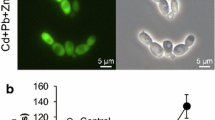Summary
Several cationic dyes were found to behave as inhibitors of K+ uptake in yeast. When added at high concentrations or in a K+-free medium, dyes can also produce and efflux of K+. The dyes are taken up by the cells in a process that, in different degrees, for several cations requires glucose and is inhibited to a higher degree by K+ than by Na+.
The inhibition of cation uptake is of the competitive type with EB and close to this type with other dyes. Ca2+ inhibits the uptake and effects of dyes and in some cases also seems to change the inhibition kinetics on Rb+ uptake closer to a pure competitive type.
According to preliminary experiments, the efflux of K+ seems to be of the electrogenic type, and not due to the disruption of the cells. The data indicate that, independently of the existence of other types of interaction (which do exist), dyes seem to interact with the system for monovalent cation uptake of yeast in different degrees of specificity and energy requirement. This interaction can be followed by fluorescence or metachromatic changes or reduction of the dyes as observed in the dual wavelength spectrophotometer and can be inhibited specifically by K+, but not by Na+.
Similar content being viewed by others
References
Akerman, K.E., Saris, N.-E.L. 1976. Stacking of safranine in liposomes during valinomycin-induced efflux of potassium ions.Biochim. Biophys. Acta 426:624
Armstrong, W.McD. 1958. The effect of some dyestuffs on the metabolism of baker's yeast.Arch. Biochem. Biophys. 73:153
Armstrong, W.McD. 1963. Surface active agents and cellular metabolism, 3. The effect of metal ions on the inhibitions by dodecyltrimethylammonium bromide of aerobic CO2 production by baker's yeast.Arch. Biochem. Biophys. 102:210
Chaix, P., Roncoli, G. 1976. Influences différentes exercées par les ions sodium et potassium sur la vitesse deréduction du blue méthylene par la levure de boulangerie en absence ou en presence de glucose.Biochim. Biophys. Acta 9:223
Colonna, R., Massari, S., Azzone, G.F. 1973. The problem of cation binding sites in the energized membrane of intact mitochondria.Eur. J. Biochem. 34:577
De Nobrega Bastos, R., Mahler, H.R. 1974. Molecular mechanisms of mitochondrial genetic activity. Effects of ethidium bromide on deoxyribonucleic acid and energetics of isolated mitochondria.J. Biol. Chem. 249:6617
Elferink, J.G.R., Booij, H.L. 1975. The action of some triphenylmethane dyes on yeast and erythrocyte membranes.Arzneim. Forsch. 25:1248
Fry, B.A. 1957. Basic triphenylmethane dyes and the inhibition of glutamine synthesis byStaphylococcus aureus.J. Gen. Microbiol. 16:341
Furhmann, G.F., Boehm, C., Theuvenet, A.P.R. 1976. Sugar transport and potassium permeability in yeast plasma membrane vesicles.Biochim. Biophys. Acta 433:583
Gale, E.F., Mitchell, P.D. 1947. The assimilation of aminoacids by bacteria. 4. The action of triphenylmethane dyes on glutamic acid assimilationJ. Gen. Microbiol. 1:299
Grimwood, B.G., Wagner, R.P. 1976. Direct action of ethidium bromide upon mitochondrial oxidative phosphorylation and morphology.Arch. Biochem. Biophys. 176:43
Hille, B. 1971. The permeability of the sodium channel to organic cations in myelinated nerve.J. Gen. Physiol. 58:599
Miko, M., Chance, B. 1975. Ethidium bromide as an uncoupler of oxidative phosphorylation.FEBS Lett. 54:347
Passow, H., Rothstein, A., Lowenstein, B. 1959. An all or none response in the release of potassium by yeast cells treated with methylene blue and other basic redox dyes.J. Gen. Physiol. 43:97
Peña, A. 1973. Studies with guanidines on the mechanism of K+ transport in yeast:FEBS Lett. 34:117
Peña, A. 1975. Studies on the mechanism of K+ transport by yeast.Arch. Biochem. Biophys. 167:397
Peña, A. 1978. Effect of ethidium bromide on Ca2+ uptake by yeast.J. Membrane Biol. 42:199
Peña, A., Chávez, E., Cárabez, A., Tuena de Gómez Puyou, M. 1977. The metabolic effects and uptake of ethidium bromide by rat liver mitochondria.Arch. Biochem. Biophys. 180:522
Peña, A., Piña, M.Z., Escamilla, E., Piña, E. 1977. A novel method for the rapid preparation of coupled yeast mitochondria.FEBS Lett. 80:209
Peña, A., Ramírez, G. 1976. Interaction of ethidium bromide with the transport system for monovalent cations in yeast.J. Membrane Biol. 22:369
Reeves, J.P., Schechter, E., Weil, R., Kaback, H.R. 1973. Dansylgalactoside, a fluorescent probe of active transport in bacterial membrane vesicles.Proc. Nat. Acad. Sci. USA 70:2722
Rothstein, A. 1974. Relationship of cation influxes and effluxes in yeast.J. Gen. Physiol. 64:608
Ryan, J.P., Ryan, H. 1972. The role of intracellular pH in the regulation of cation exchanges in yeast.Biochem. J. 128:139
Theuvenet, A.P.R., Borst Pauwels, G.W.H. 1976. Kinetics of ion translocation across charged membranes mediated by a two site transport mechanism. Effects of polyvalent cations upon rubidium uptake into yeast cells.Biochim. Biophys. Acta 426:746
Waring, M.J. 1964. Complex formation with DNA and inhibition ofEscherichia coli RNA polymerase by ethidium bromide.Biochim. Biophys. Acta 87:358
Waring, M.J. 1965. Complex formation between ethidium bromide and nucleic acids.J. Mol. Biol. 13:269
Weth, G. 1967. Biologische Wirkungen von Malachitgrün. 1. Mitteilung: Übersicht über bisher bekannte Wirkungen.Arzneim. Forsch. 17:1
Weth, G., Boiteux, A. 1967. Zur biologischen Wirkung von malachitgrün. 5. Mitteilung: Die Wirkung von Triphenylmethanfarbstoffen auf die oxidative Phosphorylierung in isolierten Ratlebermitochondrien.Arzneim. Forsch. 17:1231
Author information
Authors and Affiliations
Rights and permissions
About this article
Cite this article
Peña, A., Mora, M.A. & Carrasco, N. Uptake and effects of several cationic dyes on yeast. J. Membrain Biol. 47, 261–284 (1979). https://doi.org/10.1007/BF01869081
Received:
Revised:
Issue Date:
DOI: https://doi.org/10.1007/BF01869081




